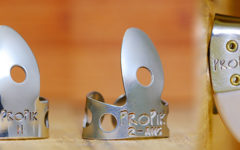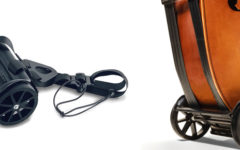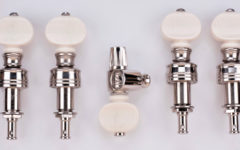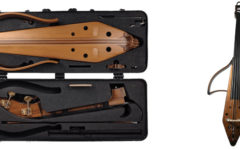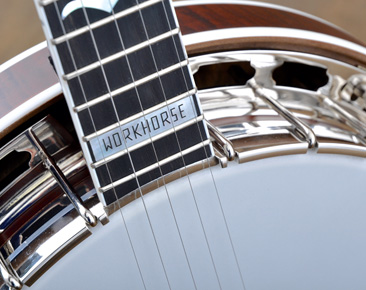
 When Steve Huber introduced his new Workhorse banjo model in 2014, it immediately called Mike Rowe to mind – the guy who’s made a living on TV extolling the virtues of hard work and dirty jobs. The ones that society values – and needs – but nobody wants to do.
When Steve Huber introduced his new Workhorse banjo model in 2014, it immediately called Mike Rowe to mind – the guy who’s made a living on TV extolling the virtues of hard work and dirty jobs. The ones that society values – and needs – but nobody wants to do.
That was the idea behind the Workhorse, to build a professional grade workingman’s banjo without the bells and whistles, and offered for sale at a price well below what the prestige models demanded.
Two things drove his reasoning, in roughly equal parts. First, as his own Huber banjos came to involve more hi-tech manufacturing processes, prices rose accordingly. In particular, his Truetone series, developed after substantial amounts of research and testing, raised the prices of his most popular models by close to $1000. Secondly, the cessation of banjo building by the Gibson company following flooding at their Nashville facility in the Spring of 2010 left a hole in the market that he wanted to fill.
So Huber began to study ways he could drop his production costs, which generally means reducing the amount of time an employee spends doing hand work. I know from discussions with Steve that he examined all options during the R&D process for this model. He had multiple discussions with overseas importers, looking at ways to reduce costs. But in the end, he stuck with his long-time philosophy of controlling as many aspects of production as possible, not being satisfied to sacrifice consistency to save money.
And how well did they do? Huber sent us a new example to review, and we were very impressed.
![]() On first inspection, I saw very little difference in appearance between the new Workhorse and my roughly 15-year-old Huber Lancaster. The finish is not rubbed out to a high gloss, a time-saving touch that does nothing to the tone or responsiveness of the banjo. The neck was precisely fitted to the pot, and the flange properly seated in the resonator – as you would expect on a pro-grade instrument.
On first inspection, I saw very little difference in appearance between the new Workhorse and my roughly 15-year-old Huber Lancaster. The finish is not rubbed out to a high gloss, a time-saving touch that does nothing to the tone or responsiveness of the banjo. The neck was precisely fitted to the pot, and the flange properly seated in the resonator – as you would expect on a pro-grade instrument.
Upon first playing the banjo, it was apparent that the fret scale was accurately cut, again as I would expect from Huber, who mills necks and fingerboards with computer-assisted cutting tools, with a scale of his computation programmed in. Waverley V-2 tuners were installed, the same as are used on the pricier models.
Many of the components are the same used in the Truetone banjos. The necks are essentially identical, minus the hand-rubbed finish, with the fingerboard bound in white. The neck and headstock inlays follow the old “Birds & Bows” pattern, and the headstock uses the double cut shape. The fret ends were carefully trimmed, extending partially across the binding. The same is true of the flange, arm rest, tailpiece, flange, and resonator, again absent the gloss finish.
I played a few of the Earl Scruggs licks I generally use to warm up with, ones that also utilize several different positions on the neck. Tone and response were consistent up and down the ebony fingerboard, and I found the banjo to be very lively for one just assembled a few days earlier.
I had a friend stop by to play it as well, someone with banjo building experience, and many years of familiarity with Hubers. He agreed with my assessment that this new Workhorse was surprisingly bold and peppy for its price, and that the fit and finish were of the highest order. I subsequently took it to a rehearsal where it performed well in a band setting.
Here Huber uses the same steam-bent, 3-ply maple rims that he used in his earliest banjos, prior to the development of his Engineered Rim. Made for Huber by Bryan Sims, it is cut to accept a tone ring made to prewar spec, involving a slightly longer outer skirt.
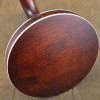 The ring itself is neither Huber’s celebrated HR-30, nor his Vintage Flathead which started the whole Huber vintage vibe in the late 1990s. It is what they call their 844 ring, one they make for OEM use by other builders, poured with a red brass alloy, and cut and plated in the Huber shop.
The ring itself is neither Huber’s celebrated HR-30, nor his Vintage Flathead which started the whole Huber vintage vibe in the late 1990s. It is what they call their 844 ring, one they make for OEM use by other builders, poured with a red brass alloy, and cut and plated in the Huber shop.
The pot is completed with a Huber head and bridge.
By comparison with my older Lancaster, fitted with Truetone parts, this new banjo lacked some of the richness and complex overtones that have led many pro players to tour with Huber banjos. Some of that was no doubt a factor of age, and this Workhorse will certainly mature with more playing. But some is certainly due to close similarity between Huber’s Engineered Rim and HR-30 tone ring to the ones in the vaunted prewar flatheads, and that comes at a premium. In short, it offers considerably more than half the banjo at close to half the price.
The curly maple version I tested sells for $2659 with a hard shell Superior Instruments case and limited lifetime warranty. The case is lined with green plush, and includes a headstock support wedge, and long compartment. A mahogany model is offered at the same price, making them price competitive with the more costly Asian imports which lack this attention to detail. Deluxe models, gold plated and engraved, sell for $3250.
At this time, the Huber Banjos web site is in the process of redesign, but they invite customer contact by email or phone (615-264-4959) for more information.

